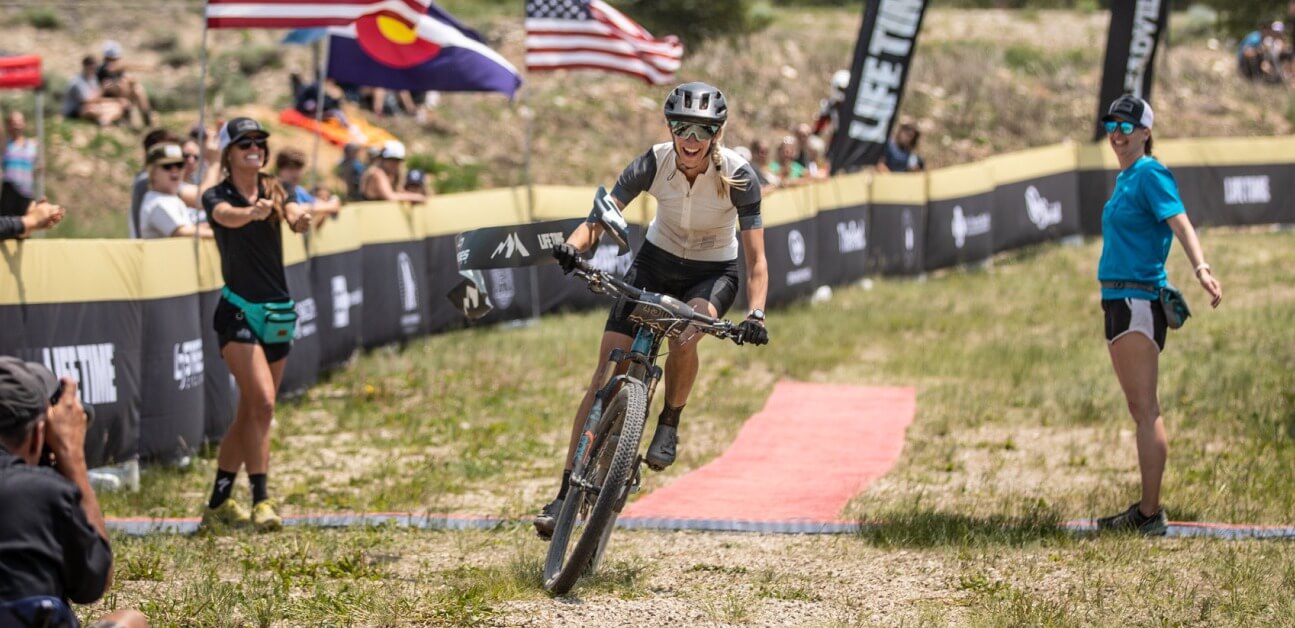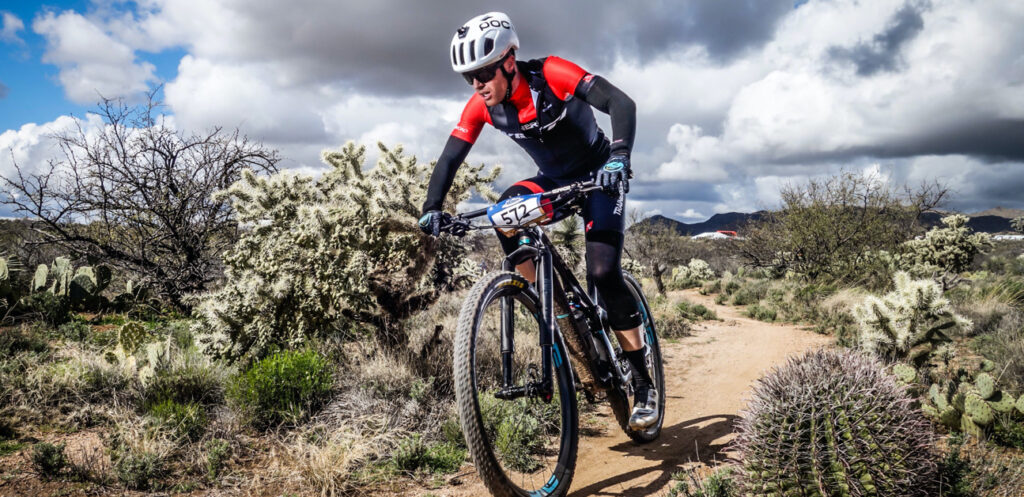The Silver Rush 50 MTB: How to Prepare for Fifty Miles at Leadville

While preparing for the Silver Rush 50, athlete Kate McLaughlin sustained an injury that would keep her off her mountain bike for months. Eager to keep her Leadville goals on track, Kate found a new approach to training that resulted in an all-time personal fitness and the fastest women’s time at the 2021 Silver Rush 50. Here’s how Kate trained for her first long-distance mountain bike race and her tips for success at the Silver Rush 50.
Share your success story and tell us how TrainerRoad helped you reach your goals.
Leadville’s Silver Rush 50 MTB
The Silver Rush 50 MTB is a fifty-mile mountain bike race based in Leadville, Colorado. The race is an epic day in the saddle with a start line that sits more than 10,000 feet above sea level and a course that accumulates over 7,000 ft of climbing. Every summer, hundreds of athletes are drawn to the Silver Rush 50 to conquer the challenging course and attempt to qualify for the Leadville 100.
For athlete Kate McLaughlin, personal ties to the Leadville race series and a goal to race the Leadville 100 were what drew her to the start line of the Silver Rush 50 MTB race. When she signed up for the race, Kate had already earned a spot at the Leadville 100 through Leadville’s lottery system, so she didn’t need a qualification. What she wanted was some long-distance mountain bike racing experience. Going into the 2021 season, Kate had a few seasons of mountain biking under her belt but no off-road race experience. Looking for some extra preparation on her way to the Leadville 100, Kate decided she would race the Silver Rush 50 too.
Training for the Silver Rush 50 MTB Race
Like many athletes, Kate’s preparation for her big event wasn’t without setbacks. Early on in her preparation for the Silver Rush 50, Kate injured her hand in a gravel bike crash. With surgery on the calendar and her hand in a cast, Kate faced several months away from her mountain bike. While this might deter some cyclists from a goal as daunting as racing at Leadville, it only reinforced Kate’s goals. As soon as she knew she wouldn’t be able to ride outside, Kate got on TrainerRoad and built a custom training plan with Plan Builder.
Kate’s custom training plan included a Sweet Spot Base II phase, a Sustained Power Build phase, and a Cross Country Marathon phase. The first phase in this progression, Sweet Spot Base II is composed of endurance, sweet spot, and threshold workouts aimed to increase muscular endurance and build a robust aerobic engine for long rides. The Sustained Power Build phase introduces more VO2 max efforts and harder threshold workouts to increase strength, endurance, and fatigue resistance—all necessary abilities for the long sustained climbs of the Silver Rush 50. Finally, the Cross Country Marathon plan rounds out the preparation, focusing on short, highly repeatable bursts of power coupled with efforts to increase your power and keep it there for high extended lengths of time. It’s a perfect combination for a long, distanced mountain bike race with sustained climbs like the Silver Rush 50 or the Leadville 100.
Kate’s Silver Rush 50 MTB Training Plan
Because Kate had experience training at a higher volume, she was able to opt for the mid-volume training plan, which includes five structured workouts per week. With that said, while she knew she could handle this much-structured training, she also knew herself well enough to know that five days spent entirely indoors wouldn’t be sustainable for her. So, to get some time outside amid her injury, Kate also swapped some of her indoor trainer workouts for outdoor trail runs. Swapping her structured workouts for trail runs helped her stay on track with her training plan and keep her motivation high.
In her preparation, Kate didn’t notice any dramatic FTP increases or shifts in performance. Instead, she saw a gradual increase in her ability to do work and push her threshold power for longer durations. By the time she got on her mountain bike for the first time in June, Kate felt fitter than she ever had. “I was going uphill faster than I think I’ve ever gone uphill…I felt so fit.”
Kate’s Tips for Racing the Silver Rush 50
When race week arrived, Kate felt strong and ready to go—unfortunately, her hand was a few steps behind her. While she was cleared to do the race, she was experiencing moderate pain in her hand. That paired with concern from her doctors that she might reinjure it in a crash meant Kate would need to take it easy if she wanted to race. Confident in her bike handling skills and determined to see her goals through, Kate decided she’d still race. Instead of racing against the field though, she decided she’d focus on these three goals: 1. Don’t crash. 2. Ride your own race. 3. Have fun.
On race day, she focused all of her efforts on pacing her own race, taking in fuel, having fun, and keeping it rubber-side down. When she crossed the finish line, she was the fastest woman of the day. Here’s what Kate learned on race day and what she recommends for any athlete who wants to do this race.
1. Watch Out for These Sections
The Silver Rush 50 is an out and back course composed of four sustained climbs and four long descents. Generally speaking, the course isn’t super technical. If you’re solid on the fundamentals, you should be in good shape throughout this race. Kate says, “The downhills are just the right amount of technical, that most can make it down no problem, and if you like the downhill aspect, you’re going to have a whole lot of fun making up time on the descents. There’s plenty of uphill and downhill that’s not technical at all, though (more so than not).”
With that said, there are a few sections Kate recommends watching out for. Particularly, some of the steeper technical uphills. “The hike-a-bike uphill sections were tough! They’re short, steep, technical stretches on the way out. There were some sections I think I would’ve been able to clear if there was nobody in front of me, but many people lost traction and had to unclip during these sections. You have to navigate other’s body language and try to anticipate this if you want a chance at clearing it.”
Adaptive Training
Get the right workout, every time with training that adapts to you.
Check Out TrainerRoadThe start offers some surprising challenges too. “The timing mat for the start is actually at the top of a steep hill you have to run up with your bike when the start gun goes off. Don’t feel the need to sprint up this, even if others are. I got to the timing mat a ways back, and I felt there was plenty of room to pass during most of the course. It’d be easy to put yourself into a hole sprinting up the start, but save your energy for the 8,000 feet of climbing you’re about to do.”
2. Pace Your own Race
A big part of Kate’s strategy was pacing her own race, making sure her pace up the climbs was sustainable. Because Kate doesn’t have a power meter on her mountain bike, she paced the event using the rate of perceived exertion (RPE). Pacing by RPE can sound tricky, if not a little risky, especially when you don’t have experience racing at that exact distance. However, despite not having experience racing a fifty-mile race, Kate didn’t have any trouble holding a sustainable pace. Months of completing sweet spot intervals, threshold intervals, and endurance intervals meant she knew exactly what pace she could hold on the Silver Rush 50 climbs.
“I knew exactly what my legs could do over and over again, and that was the pace I went at. I don’t have a power meter, but after enough workouts on the indoor trainer, I didn’t need one to know about how many watts I was putting out. I made sure not to blow myself up during the first half, and that paid off when I pulled away from the group I had been with the entire time pretty shortly into the second half.” If you’re pacing this event without a power meter, Kate recommends really focusing on those sustained intervals in your training plan.

Generally speaking, when building out your pacing strategy Kate recommends taking it relatively easier in the first half, so that you can finish strong in the second half. “Play it safe in the first half. Stay comfortable, and don’t go too deep. It’s a long race with plenty of long descents and long climbs to go hard on later in the race.”
3. Keep It Fun, Stay Positive, and eat.
Don’t underestimate the value of Kate’s third goal—making the race a fun day. In fact, having fun on race day was Kate’s main piece of advice for other Silver Rush 50 athletes on race day. “HAVE FUN RACING!” she says. “I had such a blast! The energy at the race was high, and I loved every second of it. When you’re at mile 35 struggling through that last climb, remember everybody else is feeling the same way. And don’t forget to eat – if you listen to TrainerRoad, you already know all about fueling, but I focused on this on race day, and it played a huge role in my day”
